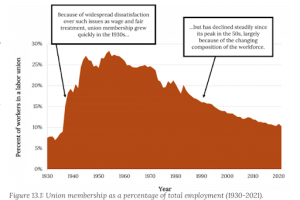12.1 Labor Unions
Adapted by Stephen Skripak with Ron Poff
As we saw in Chapter 9, Maslow believed that individuals are motivated to satisfy five levels of unmet needs (physiological, safety, social, esteem, and self-actualization). From this perspective, employees hope that full-time work will satisfy at least the two lowest-level needs: they want to be paid wages that are sufficient for them to feed, house, and clothe themselves and their families, and they expect safe working conditions and hope for some degree of job security.
Organizations also have needs: they need to earn profits that will satisfy their owners. They need to keep other stakeholders satisfied as well, which can cost money. Consider a metal-plating business that uses dangerous chemicals in its manufacturing processes; waste-water treatment is essential—and expensive. Sometimes, the needs of employees and employers are consistent: the organization can pay decent wages and provide workers with safe working conditions and job security while still making a satisfactory profit. At other times, there is a conflict—real, perceived, or a little bit of both—between the needs of employees and those of employers. In such cases, workers may be motivated to join a labor union—an organized group of workers that bargains with employers to improve its members’ pay, job security, and working conditions.
Figure 13.1 graphs labor-union density—union membership as a percentage of payrolls—in the United States from 1930 to 2021. As you can see, there’s been a steady decline since the middle part of the 1950s. [1]

Based on a 2022 report by the Bureau of Labor and Statistics (BLS), “In 2021, the number of wage and salary workers belonging to unions continued to decline (-241,000) to 14.0 million, and the percent who were members of unions—the union membership rate—was 10.3 percent. The rate was down from 10.8 percent in 2020—when the rate increased due to a disproportionately large decline in the total number of nonunion workers compared with the decline in the number of union members. The 2021 unionization rate is the same as the 2019 rate of 10.3 percent. In 1983, the first year for which comparable union data are available, the union membership rate was 20.1 percent and there were 17.7 million union workers.” [2]
From the 1950s, only union membership among public workers (those employed by federal, state, and local governments, such as teachers, police, and firefighters) grew. In the 1940s, 10 percent of public workers and 34 percent of those in the private sector belonged to unions. Today, this has reversed: 36 percent of public workers and 7 percent of those in the private sector are union members.[3]
Why the decline in private sector unionization? Many factors can come into play. For example, the relatively weak economy has reduced the number of workers who have the confidence to go through a union-organizing campaign; many workers are content just to have jobs and do not want to be seen as “rocking the boat.” In addition, the United States has shifted from a manufacturing-based economy characterized by large, historically unionized companies to a service-based economy made up of many small firms that are harder to unionize.[1]
Union Structure
Unions have a pyramidal structure much like that of large corporations. At the bottom are locals that serve workers in a particular geographical area. Certain members are designated as shop stewards to serve as go-betweens in disputes between workers and supervisors. Locals are usually organized into national unions that assist with local contract negotiations, organize new locals, negotiate contracts for entire industries, and lobby government bodies on issues of importance to organized labor. In turn, national unions may be linked by a labor federation, such as the American Federation of Labor and Congress of Industrial Organizations (AFL–CIO), which provides assistance to member unions and serves as a principal political organ for organized labor.
Chapter Videos
There are two videos for this chapter, in order to present two opposing points of view as well as some useful history. Pay attention for the historical benefits we take for granted today but that came about as a result of efforts by unions.
(Copyrighted material)
(Copyrighted material)
Key Takeaways
- Labor unions are organized groups of workers that bargain with employers to improve members’ pay, job security, and working conditions.
Video Credits: Chapter 12
Thomson Reuters Compliance Learning (2009, November 6). “Managing in a Union Environment.” YouTube. Retrieved from: https://www.youtube.com/watch?v=tPqS-HdqnUg
History (2017, September 26). “The Labor Movement in the United States.” YouTube. Retrieved from: https://www.youtube.com/watch?v=ewu-v36szlE&=&feature=youtu.be
- Kris Maher (2010). “Union Membership Drops 10%.” Wall Street Journal. Retrieved from: http://www.wsj.com/articles/SB10001424052748703822404575019350727544666; Steven Greenhouse (2011). “Union Membership in U.S. Fell to a 70-Year Low Last Year.” New York Times. Retrieved from: http://www.nytimes.com/2011/01/22/business/22union.html ↵
an organized group of workers that bargains with employers to improve its members’ pay, job security, and working conditions
to serve as go-betweens in disputes between workers and supervisors
that assist with local contract negotiations, organize new locals, negotiate contracts for entire industries, and lobby government bodies on issues of importance to organized labor

